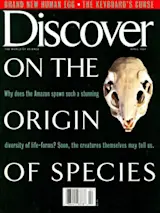The rocky mountains are one of the world’s great geologic features, yet it’s never been clear how they achieved their status. The problem is this: the Rockies have the same structure as ranges such as the Himalayas, which, as a rule, form when one of the slowly shifting tectonic plates that make up Earth’s crust collides with another. But there is no landmass pressing up against North America; the Pacific plate is sliding along the west coast, not ramming against it.
Two geologists have now proposed a new scenario: they say the Rockies are a case of hit and run mountain building. Julie Maxson of Carleton College in Northfield, Minnesota, and Basil Tikoff of the University of Minnesota believe the culprit is an 800-mile-long stretch of crust called Baja bc, which now forms the edge of British Columbia, including Vancouver Island. This rock, they say, is the remnant of an island chain the size of Japan that pushed up the Rockies.
For almost two decades many geologists have suspected that the 210-million-year-old rocks on the British Columbia coast didn’t originate there. Magnetic grains in the rocks suggest a more southerly origin. The grains behave like little compass needles as the rock first solidifies, aligning with Earth’s magnetic field. The field is vertical at the poles and becomes horizontal at the equator, sweeping through 90 degrees over the intervening latitudes. In the rocks of Vancouver Island, the angle of the magnetic grains is too shallow for them to have formed at such a high latitude.
In the early 1980s a geologist noted that the anomalous magnetic imprint of these rocks perfectly matched rocks in southern New Mexico. The enigmatic rocks became known as Baja bc, yet geologists have since failed to find any trace of a fault along which they could have migrated to their current location. The rocks also contain a layer of 85-million-year-old sediments most likely of North American origin that show they probably rammed the continent at about the time the Rockies formed.
Until now, most geologists believed that the Farallon plate, a piece of crust that has now mostly sunk into the mantle below North America, pushed up the Rockies when it plunged beneath the continent. Such is the way old crustal plates die. New crust wells up from fissures below the ocean floor. The Farallon plate--a part of which survives off Mexico-- is thought to have begun its descent into the mantle 100 million years ago, raising a chain of active volcanoes along the North American coast. Some 15 million years into the Farallon plate’s purported dive beneath North America, however, the coastal volcanoes shut off. To explain the volcanic shutdown, geologists have proposed that the Farallon plate changed its trajectory abruptly in mid-descent; the plate’s dive became less steep, and it scraped up against the underside of North America and pushed up the Rockies. This shallow dive would have prevented the crust from melting, thus cutting off the fuel for volcanic eruptions on the coast.
Tikoff says that model has serious problems. He has made a careful study of rocks in the Sierra Nevada of California and noted that the rocks that formed there just before the volcanoes quieted down were stretched. If the Farallon plate was diving beneath North America, it would have compressed these rocks, not stretched them.
Maxson and Tikoff believe that the Farallon plate’s dive beneath North America was blocked when a large chain of islands on its upper surface jammed against the North American plate. By blocking the Farallon’s descent, this island chain--which eventually broke off to become Baja bc-- might have shut off the coastal volcanoes. Without a sinking plate and melting rock, the volcanoes would run out of fuel.
Trapped against North America and pressured from the west and south by the Farallon plate, Baja bc broke off from the Farallon and darted north, on top of a large fragment of the Farallon called the Kula plate. Baja bc could have stretched the coastal rocks as it began to move up the coast. Squeezed against the coast, it would also have exerted pressure on the continental interior, raising the Rockies.
If Baja bc did travel up the coast, it may have left fragments behind, and Maxson and Tikoff will soon be looking for them. What’s exciting about this, says Maxson, is that we are generating new ways of thinking about an old problem.














